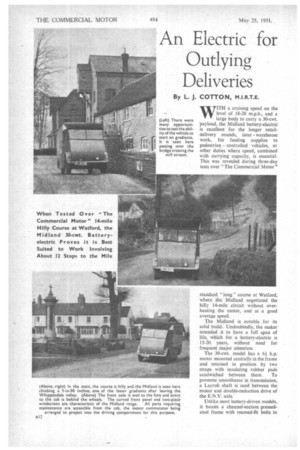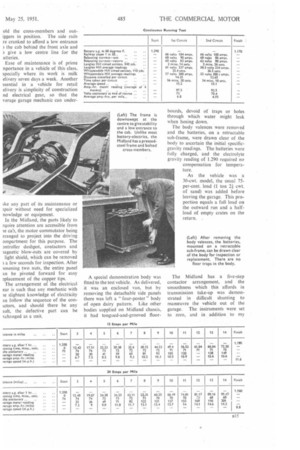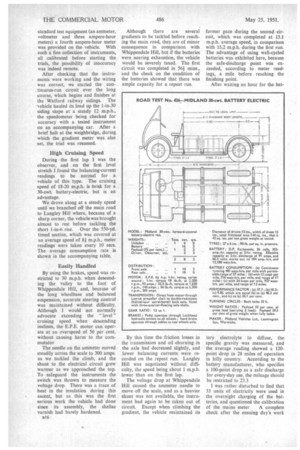An Electric for Outlying Deliveries
Page 46

Page 49

Page 50

Page 53

If you've noticed an error in this article please click here to report it so we can fix it.
By L. J. COTTON, M.I.R.T.E.
W1TH a cruising speed on the level of 18-20 m.p.h., and a large body to carry a 30-cwt. payload, the Midland battery-electric is excellent for the longer retaildelivery rounds, inter warehouse work, for feeding supplies to pedestrian controlled vehicles, or other duties where speed, combined with carrying capacity, is essential. This was revealed during three-day tests over "The Commercial Motor"
standard " long " course at Watford, where the Midland negotiated the hilly 14-mile circuit without overheating the motor, and at a good average speed.
The Midland is notable for its solid build. Undoubtedly, the maker intended it to have a full span of life, which for a battery-electric is 15-20 years. without need for frequent major attention.
The 30-cwt. model has a 61 h.p. motor mounted centrally in the frame and retained in position by two straps with insulating rubber pads sandwiched between them. To promote smoothness. in transmission,
Layrub shaft is used between the motor and double-reduction drive of the E.N.V. axle.
Unlike most battery-driven models, it boasts a channel-section pressedsteel frame with reamed-fit bolts to old the cross-members and outiggers in position. The side rails re cranked to afford a low entrance ) the cab behind the front axle and 3 give a low centre line for the atteries.
Ease of maintenance is of prime nportance in a vehicle of this class, specially where its work is milk elivery seven days a week. Another ssential in a vehicle for retail elivery is simplicity of construction rid electrical gear, so that the verage garage mechanic can under tke any part of its maintenance or !pair without need for specialized nowledge or equipment.
In the Midland, the parts likely to !quire attention are accessible from le cab, the motor commutator being rranged to project into the driving ompartment for this purpose. The 3ntroller dashpot, contactors and tagnetic blow-outs are covered by light shield, which can be removed a few seconds for inspection. After )osening two nuts, the entire panel an be pivoted forward for easy !placement of the copper tips.
The arrangement of the electrical ear is such that any mechanic with le slightest knowledge of electricity an follow the sequence of the conictors, and should there be any atilt, the defective part can be xchanged as a unit. A special demonstration body was fitted to the test vehicle. As delivered, it was an enclosed van, but by removing the detachable side panels there was left a " four-poster " body of open dairy pattern. Like other bodies supplied on Midland chassis, it had tongued-and-grooved floor boards, devoid of traps or holes through which water might leak when hosing down.
The body valences were removed and the batteries, on a retractable sub-frame, were drawn clear of the body to ascertain the initial specificgravity readings. The batteries were fully charged, and the electrolyte gravity reading of 1.290 required no compensation for temperature.
As the vehicle was a 30-cwt. model, the usual 75per-cent. load (1 ton 2i cwt. of sand) was added before leaving the garage. This proportion equals a full load on the outward run and a halfload of empty crates on the return.
The Midland has a five-step contactor arrangement, and the smoothness which this affords in transmission take-up was demonstrated in difficult shunting to manceuvre the vehicle out of the garage. The instruments were set to zero, and in addition to my
statidard test equipment (an ammeter, voltmeter and three ampere-hour meters) a fourth ampere-hour meter was provided on the vehicle. With such a fine collection of instruments, all calibrated before starting the trials, the possibility of inaccuracy was indeed remote.
After checking that the instru, merits were working and the wiring was correct, we started the continuous-run circuit over the long course, which begins and finishes at the Watford railway sidings. The -vehicle hauled its load up the 1-in-30 siding slope at a steady 12 m.p.h., the speedometer being checked for accuracy with a tested instrument on an accompanying car. After a brief halt at the weighbridge, during which the gradient meter was also set, the trial was resumed.
High cruising Speed
During the first lap I was the observer, and on the first level stretch I found the balancing-current readings to be normal for a vehicle of this type. The cruising speed of 18-20 m.p.h. is brisk for a 30-cwt. battery-electric, but is an advantage.
We drove along at a steady speed until we branched off the main road to Langley Hill where, because of a sharp corner, the vehicle was brought almost to rest before tackling the short 1-in-6 rise. Over the 550-yd. timed section, which was covered at an average speed of 8f m.p.h., meter readings were taken every 10 secs. The average consumption rate is shown in the accompanying table.
Easily Handled
By using the brakes, speed was restricted to 30 ni.p.h. when descending the valley to the foot of Whippendale Hill, and, because of the long wheelbase and balanced suspension, accurate steering control was maintained without difficulty. Although I would not normally advocate exceeding the " level" cruising speed when descending inclines, the E.P.E. motor can operate at an overspeed of 50 per cent. without causing harm to the commutator
The needle on the ammeter moved steadily across the scale to 300 amps. as we tackled the climb, and the shunt to the electrical circuit grew warmer as we approached the top. To safeguard the instruments the switch was thrown to measure the voltage drop. There was a trace of heat in the insulation during this ascent, but as this was the first serious work the vehicle had done since its assembly, the shellac varnish had barely hardened.
BIG Although there are several gradients to be tackled before reaching the main road, they are of minor consequence in comparison with Whippendale Hill, but if the batteries were nearing exhaustion, the vehicle would be severely taxed. The first circuit was completed in 56f mins., and the check on the condition of the batteries showed that there was ample capacity for a repeat run.
By this time the friction losses in the transmission and oil churning in the axle had decreased slightly, and lower balancing currents were recorded on the repeat run. Langley Hill was negotiated without difficulty, the speed being about 1 m.p.h. lower than on the first lap.
The voltage drop at Whippendale Hill caused the ammeter needle to move off the scale, and as a heavier shunt was not available, the instrument had again to be taken out of circuit. Except when climbing the gradient, the vehicle maintained its former pace during the second circuit, which was completed at 15.1 m.p.h. average speed, in comparison with 15.2 m.p.h. during the first run. The advantage of using well-cycled batteries was exhibited here, because the safe-discharge point was exceeded, according to meter readings, a mile before reaching the finishing point.
After waiting an hour for the bat
tery electrolyte to diffuse, the specific gravity was measured, and the average reading showed a 120point drop in 28 miles of operation in hilly country. According to the battery manufacturer, who specifies a 100-point drop as a safe discharge for every-day use, the mileage should be restricted to 23.3 I was rather disturbed to find that 33 units of electricity were used in the overnight charging of the batteries, and questioned the calibration of the mains meter A complete check after the ensuing day's work Droved the supply meter to be in )rder, so I assume that the charging ict had an extremely low efficiency.
A three-mile non-stop run, folowed by 12 stops to every mile, Mere the prescribed conditions for he second day's work, and the Midand showed willing for this type of Juty. Instrument readings were :aken at one-mile intervals, and the ;alculator stop-watch was used to measure the running time. The tverage current consumption per nile on the level worked out to 63 tmp.-hrs., but the rate rose sharply .o 18 amp.-hrs. when negotiating ..,angley Hill, and to 16 amp.-hrs. when making the -short but sharper ;limb from the Whippendale Valley.
Smooth Starting
The five-step controller was nstrumental in providing a smooth ;etaway on the gradients, but the Drake pedal was not placed for maximum effort. I could not exert More han 75 lb. pressure in a downward hrust on the pedal, and this, &hough sufficient for normal use, s barely adequate for an emergency ipplication. It is understood that the positions of the hydraulic cylinder ind lever are being changed, so that greater power can be exerted with ess manual effort.
The course, with 12 stops per mile to the finishing point, was completed n quick time, the average running speed working out at 11.6 m.p.h. According to the meter and hydrometer, there was a further threemiles' work left in the batteries before reaching the safe-discharge point.
During the third day's trials, which were made under the same delivery :onditions, but with 24 stops per mile, the high speed of the Midland :ould not be used to full advantage. With the denser round, and stops very 70 yds., the permissible range mi the Watford course worked out to approximately 12 miles on a 100point gravity drop.
Speed Maintained
The well-cycled batteries again ;flowed to advantage during this :dal, because after 14 miles of con;inuous stop-start operation, the battery discharge was 201 amp.-hrs., Ind a 120-point drop was registered 3y the hydrometer. Even so, the tcceleration rate and maximum ;peed remained practically un:hanged from the start to finish 3f the trial.
The results of the three days' ;est show that the Midland, with its ugh-ratio final drive, is best suited to rounds of about 12 stops to the mile. Its higher speed can be used to good purpose and, on a less undulating circuit, the permissible range for everyday use would be 20 miles or more.
There are occasions when a vehicle of this type might be called upon to help out on other rounds, or to operate a shuttle service for the collection of churns after its day's work. Provided that the batteries are in reasonable condition, this would cause no difficulty and would not be harmful to the plates.
It should be noted that when the
delivery-round tests are made, the stops are of 15 seconds' duration In everyday use, when the roundsman is serving possibly five or six customers at one point, the vehicle would be stationary for much longer periods and the full range of the Midland would not be employed. The tests showed that under the most arduous conditions the vehicle could travel for over two hours without stop or causing harm to the battery. Few four-wheeled batteryelectrics are driven, in total, for longer than U hours in a full day's work.




















































































